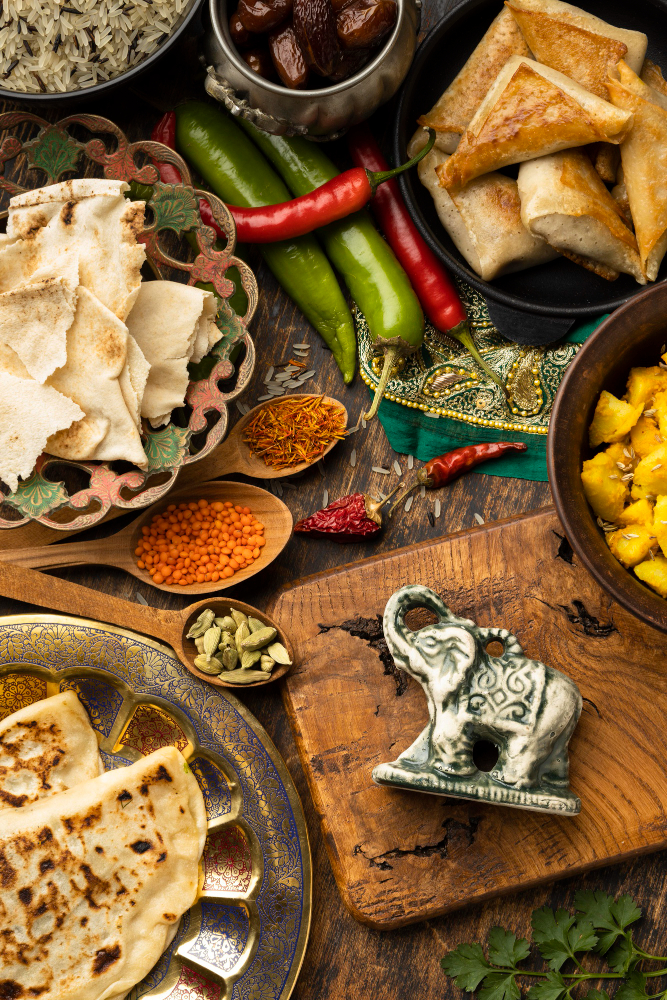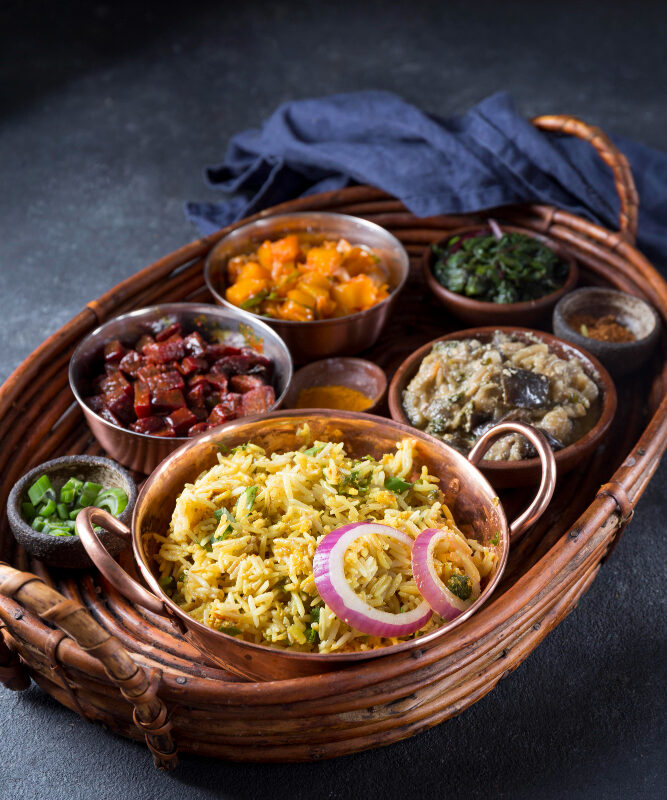
Welcome to a flavorful exploration of India’s diverse culinary traditions, where every region tells its own delicious story. India, a land of vibrant colors and diverse cultures, offers an array of flavors that tickle the taste buds and warm the soul.
In this post, we delve into the distinct and delightful differences between Northern and Southern Indian cuisines. Whether you’re a food enthusiast, a curious explorer, or simply looking for your next meal at an authentic Indian cuisine restaurant, this guide is your perfect companion.
The Flavorful North
Northern Indian cuisine is renowned for its rich, hearty dishes, often characterized by the liberal use of dairy products like milk, paneer (cottage cheese), ghee (clarified butter), and yogurt. This region favors slow-cooked, savory dishes, often simmered to perfection. One cannot talk about Northern Indian food without mentioning the beloved Tandoori Chicken, a dish where meat is marinated in a tantalizing mixture of spices and yogurt, and then cooked in a Tandoor (clay oven). The result? A smoky, tender delight that has captured hearts globally.
The Spice-Laden South
In contrast, Southern Indian cuisine is celebrated for its use of rice, lentils, and a bounty of spices. Dishes from this region are typically lighter yet boldly flavored. Think Dosa and Idli, the iconic South Indian staples. These are often accompanied by Sambar (a tangy lentil-based vegetable stew) and a variety of chutneys. Coconut plays a pivotal role here, adding a unique sweetness and texture to their dishes.
Grains of Difference: Wheat vs. Rice
Let’s dive into the staple grains that set Northern and Southern Indian cuisines apart. In the North, wheat rules the kitchen. It’s the main ingredient in popular breads like Naan and Roti. These breads are a must-have in any meal. They’re soft, fluffy, and perfect for scooping up rich, creamy gravies. Imagine visiting an authentic Indian cuisine restaurant in the North. You’ll likely find a variety of these breads, each with its unique taste and texture.
Now, let’s journey to the South. Here, rice is king. It’s more than just a side dish; it’s the star of the show. From fluffy, steamed rice to tangy, lemon rice, it’s everywhere. In Southern Indian meals, rice is central. It perfectly complements the bold flavors of the region’s stews and curries.
Spice Tales: Mild vs. Hot
Next, let’s talk spices. Northern Indian cuisine often uses a milder blend. This creates a subtle but rich flavor. Think of dishes like Korma or Malai Kofta. They have a gentle warmth, with spices like cardamom and cinnamon taking the lead. This milder approach to spice makes these dishes a hit, especially in an authentic Indian cuisine restaurant catering to diverse palates.
In contrast, Southern Indian cuisine is all about heat. It’s famous for its fiery, intense spice profiles. The generous use of chili and pepper brings a punch to every dish. From spicy Sambar to fiery Chettinad curries, the South loves its spices hot. This bold use of spices defines Southern Indian cooking and makes it unforgettable.
Both regions use spices uniquely, creating distinct and delicious experiences. Whether it’s the gentle warmth of the North or the fiery zing of the South, these flavors are a highlight in any authentic Indian cuisine restaurant.
The Creamy North: A Symphony of Flavors
Let’s dive deeper into Northern India’s culinary world. Here, creamy, tomato-based gravies take center stage. Imagine walking into an authentic Indian cuisine restaurant. The aroma of spices and simmering sauces fills the air. Dishes like Butter Chicken and Paneer Makhani showcase this tradition. In these recipes, chefs skillfully blend spices with tomatoes and cream. The result? A gravy that’s smooth, rich, and utterly delightful. Each bite of these dishes offers a comforting warmth. It’s not just food; it’s a celebration of flavors.
The Tangy South: A Dance of Sour and Spice
Now, let’s journey to Southern India. This region’s cuisine stands out with its tangy flavors. Tamarind and raw mango are the stars here. They add a unique sourness to dishes, creating a fascinating flavor balance. In an authentic Indian cuisine restaurant serving Southern dishes, you’ll notice this difference.
The tanginess cuts through the spices, creating a lighter but equally flavorful experience. It’s not just about heat; it’s about harmony. Each dish is a careful mix of sour, spice, and everything nice. This approach offers a taste experience that’s refreshing and bold.
Cooking Techniques: A Tale of Two Regions
Let’s dive deeper into the cooking styles that set Northern and Southern Indian cuisines apart. In the North, chefs often grill foods. This method, known as Tandoori cooking, is famous worldwide. Imagine marinating chicken or paneer in spices and yogurt. Then, they cook it in a clay oven, the Tandoor. This process brings out a smoky flavor that’s both rich and intricate. It’s a technique that has put many authentic Indian cuisine restaurants on the map.
In contrast, Southern Indian chefs prefer steaming and stir-frying. Take Idlis, for example. These are steamed rice cakes, light and fluffy, often served for breakfast. This method keeps the food’s natural taste and texture. Quick stir-frying is another hallmark of the South. It’s fast and keeps the vegetables crisp and fresh. Next time you visit an authentic Indian cuisine restaurant, you’ll notice these distinct cooking styles in their menu offerings.
Vegetarianism Across Regions: A Diverse Palette
Now, let’s talk about vegetarian dishes. Both North and South India offer a rich variety of vegetarian options. However, their approaches are quite different. In the North, vegetarian dishes are often heartier. They use more dairy products like paneer, ghee, and yogurt. These ingredients make the dishes creamy and rich. Think of a paneer curry from an authentic Indian cuisine restaurant. It’s likely to be smooth, creamy, and satisfying.
Meanwhile, in the South, vegetarian cuisine is lighter. Chefs there rely heavily on vegetables and lentils. Their dishes are often more about the natural flavors of the ingredients than about the richness of dairy. This results in meals that are both nutritious and flavorful, yet not too heavy. Whether it’s a Sambar, a lentil-based stew, or a vegetable stir-fry, Southern vegetarian cuisine is as diverse as it is delicious.
Conclusion
In summary, the cuisines of Northern and Southern India, while unified by their use of spices and focus on flavor, differ in their ingredients, cooking methods, and resulting tastes. These differences make Indian cuisine a fascinating and diverse culinary adventure. Whether you’re dining at an authentic Indian cuisine restaurant or experimenting with recipes at home, exploring these regional cuisines promises a delightful and flavorful experience.
Remember, the diversity in Indian cuisine reflects the rich tapestry of cultures and traditions that make up this incredible country. So next time you’re enjoying a flavorful curry or a spicy Dosa, know that you’re not just savoring a meal, but experiencing a piece of India’s rich cultural heritage. Bon Appétit!
Read More:
Indian Cuisine Restaurant Guide
Related Posts

7 Compelling Reasons to Dine at an Indian Cuisine Restaurant
Lorem ipsum dolor sit amet, consectetur adipiscing elit. Ut elit tellus, luctus nec ullamcorper mattis, pulvinar dapibus leo.

Flavors of India: Meet the Best Authentic Indian Dishes
Lorem ipsum dolor sit amet, consectetur adipiscing elit. Ut elit tellus, luctus nec ullamcorper mattis, pulvinar dapibus leo.
About Us
Est. in 2022, The Curry Modern Indian Restaurant brings fresh, bold, and modern Indian Cuisine to Huntsville, Alabama. Chef Linil is a master at Indian cuisine, providing our guests with the highest quality curries, biryanis, dosas, and more. Whether you are a seasoned foodie to Indian cuisine or new to the scene, you are sure to find your next favorite meal here at The Curry.
